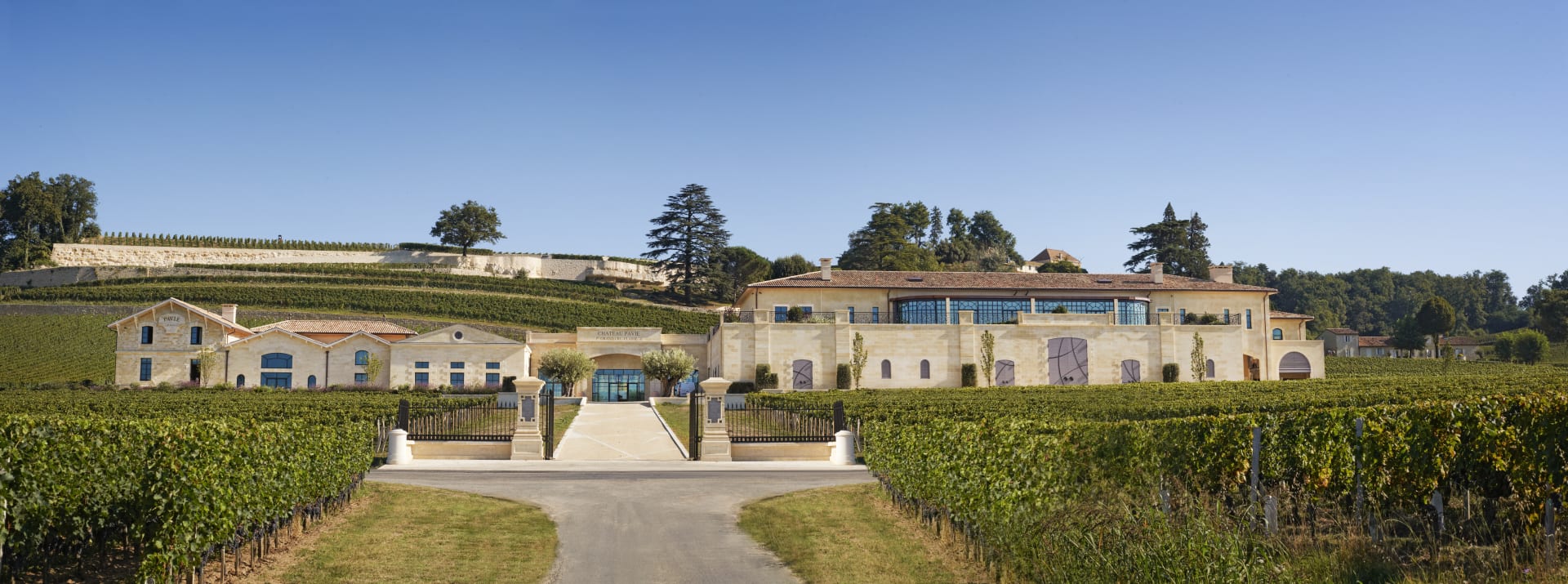Chateau Pavie 2018
-
Jeb
Dunnuck -
Robert
Parker -
James
Suckling -
Wine
Spectator - Decanter
-
Wine
Enthusiast



Product Details
Your Rating
Somm Note
Winemaker Notes
Blend: 60% Merlot, 22% Cabernet Franc and 18% Cabernet Sauvignon
Professional Ratings
-
Jeb Dunnuck
One of the wines of the vintage is the 2018 Château Pavie, and Gérard Perse continues to produce one of the greatest wines in the world, in just about every vintage. Based on 60% Merlot, 22% Cabernet Franc and 18% Cabernet Sauvignon, the 2018 shows the slightly more restrained style of the estate today yet still brings classic Pavie richness, depth, and grandeur. Revealing a deep purple color as well as a sensational bouquet of crème de cassis, damp earth, tobacco, chalk, and lead pencil shavings, it hits the palate with full-bodied richness, incredible purity, a dense, concentrated mid-palate, and a liqueur of rocks-like sense of minerality on the blockbuster finish. There's a backward, inward style here that actually reminds me of the 2000. This is another magical, probably immortal wine from this terroir that marries power with elegance perfectly. Don't miss it!
-
Robert Parker's Wine Advocate
The 2018 Pavie is a blend of 60% Merlot, 22% Cabernet Franc and 18% Cabernet Sauvignon. The wine has a 3.58 pH and 14.48% alcohol. Very deep garnet-purple in color, it bursts from the glass with a fabulously expressive nose of crème de cassis, baked plums and blueberry preserves, leading to an impressive array of nuances, featuring notions of dark chocolate, camphor, licorice, rose petals and fertile loam, plus hints of crushed rocks and iron ore. The rich, full-bodied palate offers layer upon layer of opulent black and blue fruits with loads of exotic spice sparks and pretty floral and mineral accents, supported by firm, super plush tannin's and remarkable tension, finishing with epic length and depth. This could only be Pavie. It makes for a seductively stylish glass now, but patience will be rewarded if it is afforded 5-7 years in bottle, at least, then drink it over the next 30+ years.
-
James Suckling
Impressive aromas of pure, crushed blackberries and brambleberries with red and black licorice and black olives, as well as incense, following through to a full body with round, creamy tannins and lots of fruit. Yet, it’s tight and reserved at the finish. Needs three or four years to open and start showing its true character. Powerful and linear. Cellar-bound. Try after 2026.
-
Wine Spectator
This is packed with raspberry, plum and boysenberry compote flavors that sail through thanks to the unencumbered feel provided by the polished structure. Fine chalky threads curl throughout as this opens in the glass, with flamboyant flashes of apple wood, anise and violet emerging through the finish. Youthfully dense, but everything is in proportion. Merlot, Cabernet Franc and Cabernet Sauvignon. Best from 2025 through 2040.
-
Decanter
Not so long ago, Pavie would have rejoiced in the massive tannic and alcohol potential of this vintage, but they really have done a great job practicing restraint. It doesn't sacrifice Pavie's power but of all the wines in this particular lineup it's the one that carries the weight of the vintage the best, building power by stealth rather than grabbing it from you. This is great quality, with inky depths to the black fruits, accompanied by liquorice and chocolate, and the beautiful salty lick on the finish really completes the picture - your tongue just licks the wall and it's highly enjoyable! Harvest began on 26 September, later than some in the appellation, with a 38hl/ha yield. Although extraction was kept gentle, with the grapes given a week-long cold soak before fermentation at no more than 28°C, then a five-week maceration (longer than some, but these guys used to do eight weeks or more!), they have achieved a high tannin count of 97IPT and 3.58pH.
Drinking Window 2028 - 2042
Barrel Sample: 96 -
Wine Enthusiast
The pure black currant fruits of this exemplary wine are matched with bright acidity and ripe, solid tannins. It is impressively rich and will certainly age well. Barrel Sample: 94-96.
Other Vintages
2022-
Jeb
Dunnuck -
James
Suckling - Vinous
- Decanter
-
Jeb
Dunnuck - Vinous
-
James
Suckling - Decanter
-
James
Suckling -
Jeb
Dunnuck -
Robert
Parker - Decanter
-
Wine
Spectator -
Wine
Enthusiast
-
Robert
Parker -
Jeb
Dunnuck -
Wine
Enthusiast -
James
Suckling -
Wine
Spectator - Decanter
-
Jeb
Dunnuck -
Robert
Parker -
James
Suckling -
Wine
Spectator - Decanter
-
Wine
Enthusiast
-
Robert
Parker -
James
Suckling -
Jeb
Dunnuck -
Wine
Spectator -
Wine
Enthusiast
-
James
Suckling -
Jeb
Dunnuck -
Robert
Parker -
Wine
Spectator -
Wine
Enthusiast - Decanter
-
Wine
Spectator -
James
Suckling -
Wine
Enthusiast -
Robert
Parker - Decanter
-
Wine
Enthusiast -
James
Suckling -
Robert
Parker -
Wine
Spectator
-
Wine
Spectator -
Robert
Parker -
James
Suckling -
Wine
Enthusiast
-
Jeb
Dunnuck -
Robert
Parker -
James
Suckling -
Wine
Spectator
-
Robert
Parker -
James
Suckling -
Wine
Spectator -
Wine
Enthusiast
-
James
Suckling -
Robert
Parker -
Wine
Enthusiast -
Wine
Spectator
-
James
Suckling -
Robert
Parker -
Wine
Spectator -
Wine
Enthusiast -
Wine &
Spirits
-
Robert
Parker -
Wine
Spectator -
Jeb
Dunnuck
-
Wine &
Spirits -
Wine
Spectator -
Robert
Parker
-
Robert
Parker -
Wine
Spectator
-
Robert
Parker -
Wine
Spectator
-
Robert
Parker -
Wine
Spectator
-
Jeb
Dunnuck -
Robert
Parker -
Wine
Spectator -
Wine
Enthusiast
-
Robert
Parker -
Wine
Spectator
-
Wine &
Spirits -
Robert
Parker
-
Wine
Spectator







Established on the splendid “Côte Pavie”, the vineyard of Château Pavie was planted by the roman in the 4th century who first saw the incredible potential of this terroir. The history of the property goes back to 1850 when the Pimpinelle estate was owned by Mr Fayard and Mr Chapus who, thanks to their work, managed to obtain a gold medal at the Paris World Fair.
Less than ten years later, it was bequeathed to Ferdinand Bouffard, a Bordeaux merchant who, in twenty years, managed to build up a 50-hectare estate by buying up several properties. Just after the war, it was bought by Albert Porte when Ferdinand Bouffard passed away. By unifying the properties of Mr. Bouffard, he created Château Pavie (The name comes from a particularly sweet and juicy peach variety that was growing on the slope).
Alexandre Valette took over in 1943 and succeeded in raising it to the rank of Premier Grand Cru Classé B in 1955. His grandson, who had taken over in 1957, sold it to Gérard Perse in 1998 who is still the owner today. Thanks to major investments in both the vineyard and the cellar and to additional work towards maturity and precision, the latter managed to raise his estate to the rank of Premier Grand Cru Classé “A” during the revision of the classification of Saint-Emilion wines in 2012.
The magnificence of Château Pavie comes from its exceptional terroir (37 hectares planted in one block) made of limestone, clay and sand-clay, with over 80 meters of altitude variation offering a multitude of micro-terroir, with mostly south exposure, where the typical grape varieties of the right bank (Merlot, Cabernet Franc and Cabernet Sauvignon) achieve perfect maturity.
